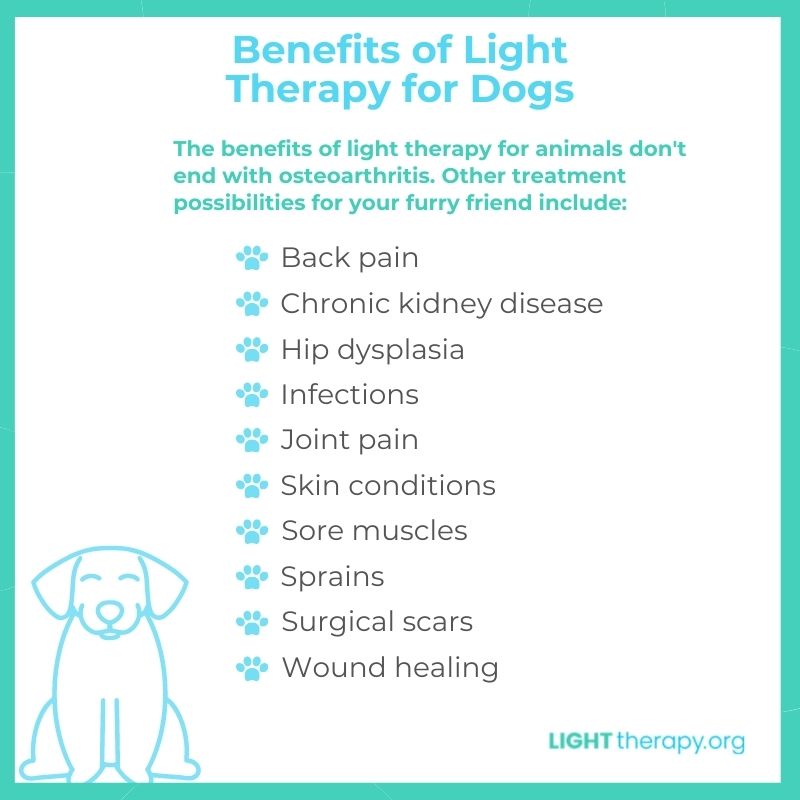How to Use Red Light Therapy on Dogs
Whether you’ve experienced the benefits of red light therapy for yourself or you’ve heard rave reviews from others, you may be eager to try it on your canine friend as well.
But since you love your dog so much, you’ll want to make sure you know how to use this therapy in a safe and effective way.
Let’s take a look at what light therapy is, how it works for animals, and how to use red light therapy on dogs.
What Is Light Therapy?
Light therapy, also sometimes referred to as phototherapy or photobiomodulation, uses specific wavelengths of light isolated from the electromagnetic light spectrum to help optimize health in the body.
Research has shown that light therapy effectively treats a range of health conditions in humans, from depression and sleep issues to eczema and psoriasis.
Red light therapy specifically isolates light wavelengths in the red or near-infrared (NIR) part of the light spectrum. Research has shown red light to be stimulating, healing, and restoring. And red light therapy’s benefits aren’t just for humans, either. Dogs, cats, and even horses have all benefited from this treatment as well.
Benefits of Light Therapy for Dogs
When it comes to light therapy in veterinary medicine, osteoarthritis is an especially well-researched topic. Multiple studies have shown light therapy to be safe and effective for this common ailment in canines.
But the benefits of light therapy for animals don’t end with osteoarthritis. Other treatment possibilities for your furry friend include:
- Back pain
- Chronic kidney disease
- Hip dysplasia
- Infections
- Joint pain
- Skin conditions
- Sore muscles
- Sprains
- Surgical scars
- Wound healing
Many veterinarians’ offices now offer red light therapy for dogs, and many devices for home use are available for purchase online. These range from red light therapy crates to velcro pads that target specific areas.

Evidence for Red Light Therapy for Dogs
Many of the studies using red light therapy for dogs are small, but most show extremely promising results.
For instance, a 2017 study evaluated the effectiveness of red light therapy on 27 dogs who were scheduled for bone surgery. The dogs were randomly assigned to receive a single treatment with low-level light therapy before surgery or provided with a placebo treatment.
No major complications arose, and the dogs in the treatment group recovered significantly faster than the placebo group. Notably, the dogs who received light therapy were older than the placebo group.
Principles for Red Light Therapy Usage
If you’re considering using red light therapy on your dog, you’ll want to make sure you use it appropriately and in the most effective way so they gain the maximum benefit in the shortest amount of time.
Before you begin the red light therapy treatment, make sure your dog is as comfortable and calm as possible. Make sure he has relieved himself outside, has recently eaten, and has adequate access to water.
Depending on the red light therapy device, your dog may be able to roam freely during his treatment, or you may need to keep him comfortably situated in your lap. If the device is a crate or kennel, some treats or toys might help your dog relax inside.
For best results, light should be able to reach your dog’s skin directly, or with as little fur coverage as possible. If you’re using a handheld device, you can part your dog’s hair over the treatment area for better light access.
Especially with home-use devices, the effects of red light therapy build up over time. You may not see results right away, but consistency is key. If you continue treatments with an effective device, you should start to see some benefits. For chronic conditions, symptoms will return if you discontinue red light treatments.
How to Use Red Light Therapy on Dogs
Many veterinarians have been using red light therapy in their practices for a decade or more, but the study of red light therapy for dogs is still very much in its infancy. Because data is still being gathered, there is currently no overall strategy for red light therapy usage that’s universally applicable across all dogs, all conditions, and all devices.
Because of this, it’s important to do your research, choose a device appropriate for the condition you want to address, and follow the device’s instructions carefully. If you can’t locate your device’s manual, you may be able to download one from the retailer’s website or contact the manufacturer.
Devices may require anywhere from 10 minutes to several hours of use per day, and treatment type and duration can vary depending on the condition being treated. An open wound, for example, would require a different method and dose of treatment than a problem that occurs deeper within the body, like arthritis.
Red light therapy is noninvasive and nontoxic, and when used as directed, it is generally extremely safe. There are no known “overdoses” or negative side effects. However, it’s best to speak with your veterinarian before starting treatment. If your vet isn’t personally familiar with light therapy for animals, ask for a recommendation of a vet who is.